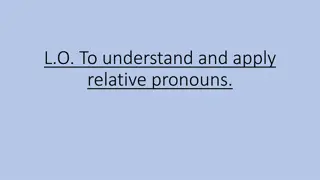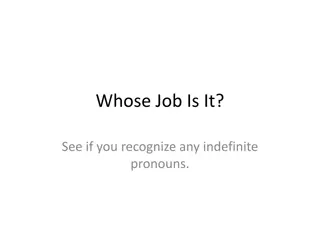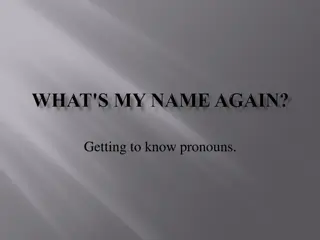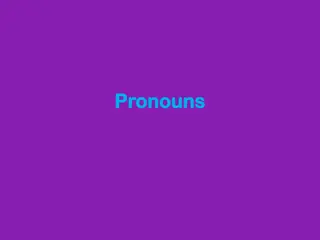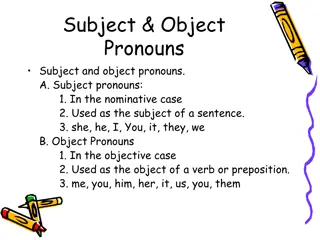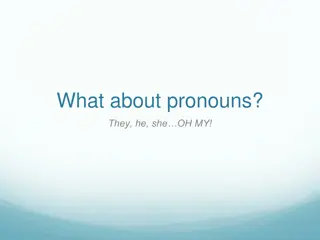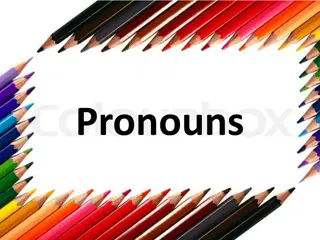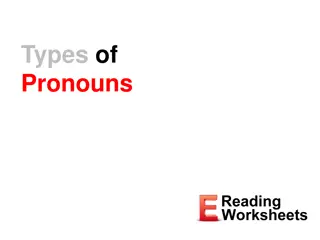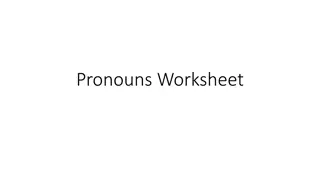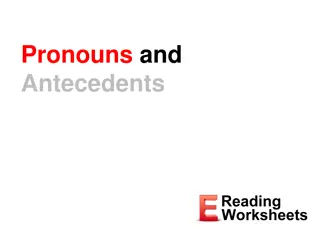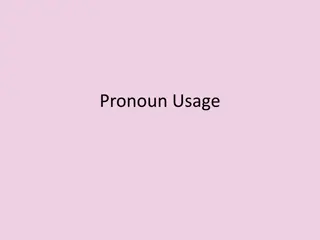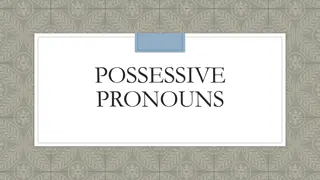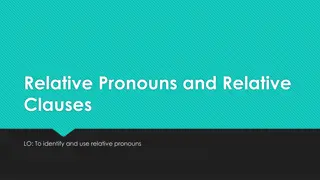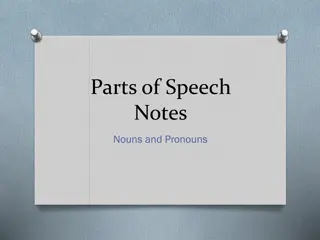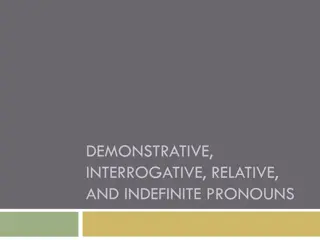Understanding Pronouns: Cases, Perspectives, and Usage
Explore the nuances of pronouns including cases, perspectives, and correct usage to enhance your language skills. Learn about subjective, objective, and reflexive pronouns, as well as how to choose the right pronoun based on the context. Enhance your command of standard English grammar and usage with practical examples and insights.
Download Presentation

Please find below an Image/Link to download the presentation.
The content on the website is provided AS IS for your information and personal use only. It may not be sold, licensed, or shared on other websites without obtaining consent from the author. Download presentation by click this link. If you encounter any issues during the download, it is possible that the publisher has removed the file from their server.
E N D
Presentation Transcript
Pronoun Case and Perspective
Subjects and Objects Nouns that take verbs are subjects Nouns that do not take verbs are objects Captain Jones waved around his saber and threatened the landlubbers. Which noun is the subject?
Pronoun Case Some pronouns change form based on whether they are subjects or object I taught myself to skateboard because nobody else would teach me. When do we use I? When do we use me? When do we use myself?
Who Cares? You sound more intelligent when you choose the correct pronoun case. Don t you want to sound more intelligent? CCSS.ELA-LITERACY.CCRA.L.1: Demonstrate command of the conventions of standard English grammar and usage when writing or speaking.
Subjective Pronouns Personal pronouns that take a verb I, we, you, he, she, they, them, it Example When we arrived in the new country, we were bearing gifts for the natives.
Objective Pronouns Personal pronouns that do not take verbs Me, us, you, it, him, her, them Example The natives were delighted to meet us.
Reflexive Pronouns Must refer or reflect on the subject Myself, ourselves, yourself, yourselves, himself, herself, themselves, itself Example Tommy the Turkey didn t want to be by himself anymore so he was happy to be invited to our table.
Choosing the Right Pronoun Use subjective pronouns as subjects and objective pronouns as objects Slow down and ask yourself, Did I do this, or did it happen to me? Examples Jed and I went to the swimming hole. The teacher gave me and Karen a hall pass. She is taller than I.
Pronoun Perspective First, second, or third-person First-Person I, me, my, myself, we, our, ours, ourselves Second-Person You, your, yours, yourself, yourselves Third-Person He, she, it, him, her, his, hers, himself, herself, itself, they, them, their, theirs, themselves
Case and Perspective Chart Subjective Objective me, us Reflexive myself, ourselves First-Person I, we you you yourself, yourselves Second- Person he, she, they, it, him, her, them, it himself, herself, themselves, itself Third- Person
More Examples of Pronoun Case My Dad and _______ were planting a tree for Earth Day. Do we need a subjective or objective pronoun? Subjective
More Examples of Pronoun Case Alyssa was pleased when the teacher put ______ and Ahmad in a group. Do we need a subjective or objective pronoun? Objective
More Examples of Pronoun Case The patient tried to run from Nurse Christie but ______was faster than ______. Do we need a subjective or objective pronoun? Subjective
Review Subjective pronouns take verbs. Objective pronouns do not take verbs. Reflexive pronouns reflect on the subject.




